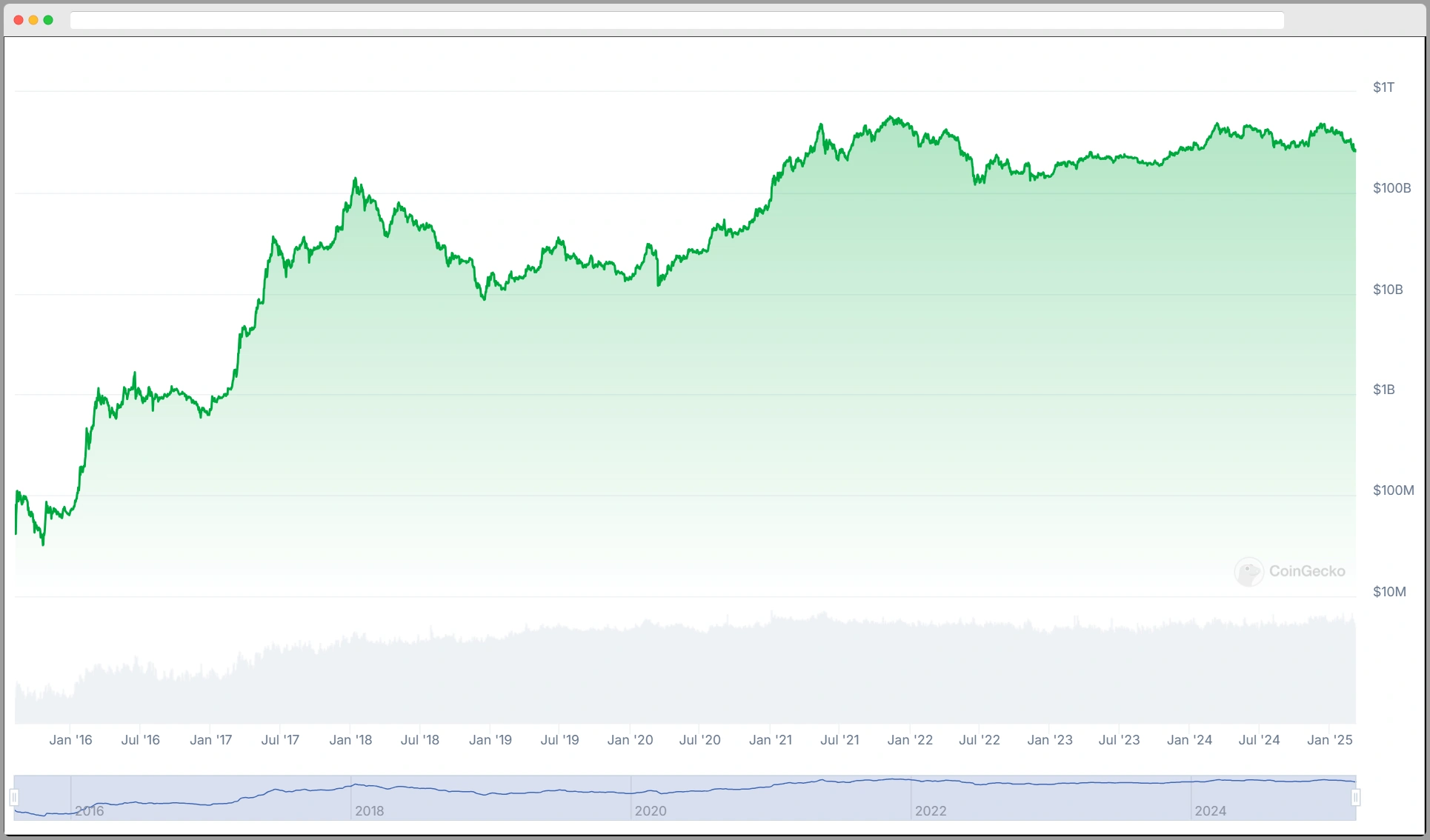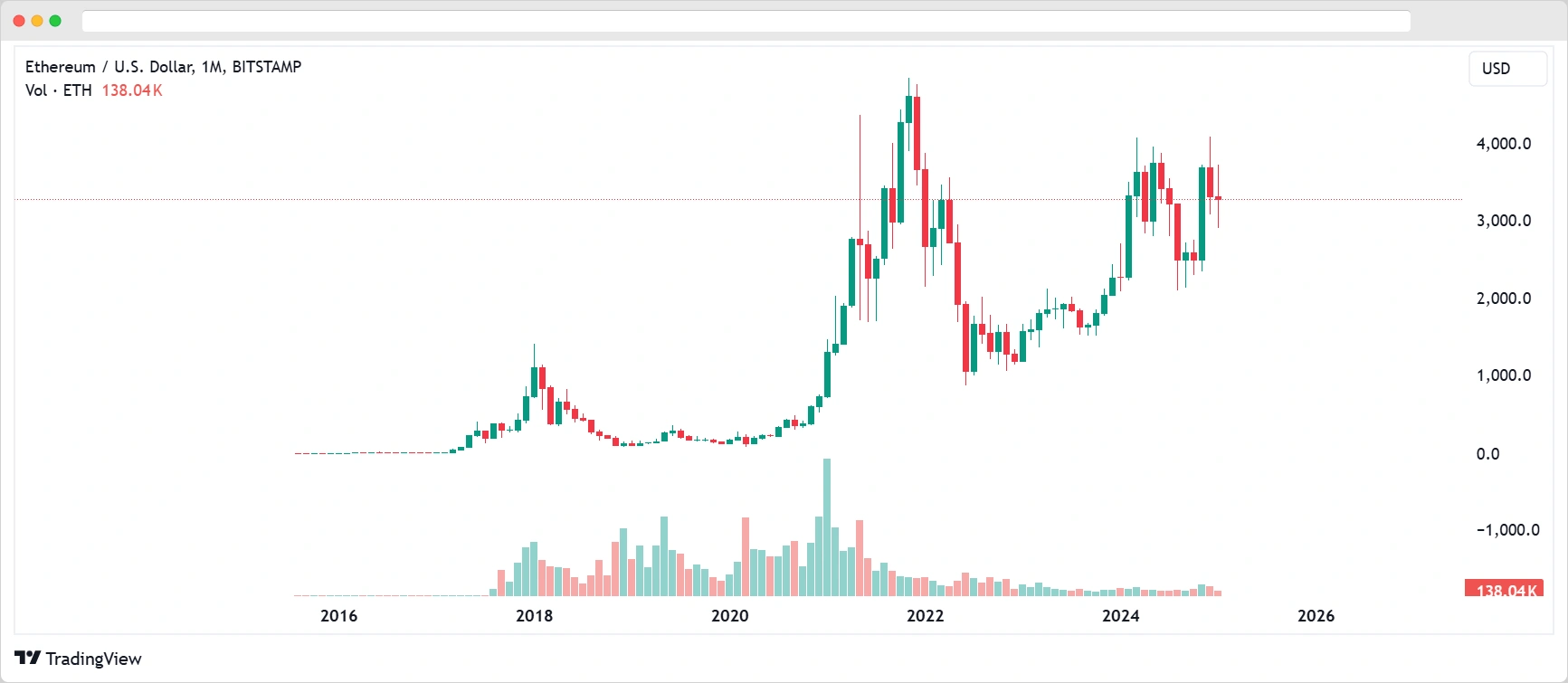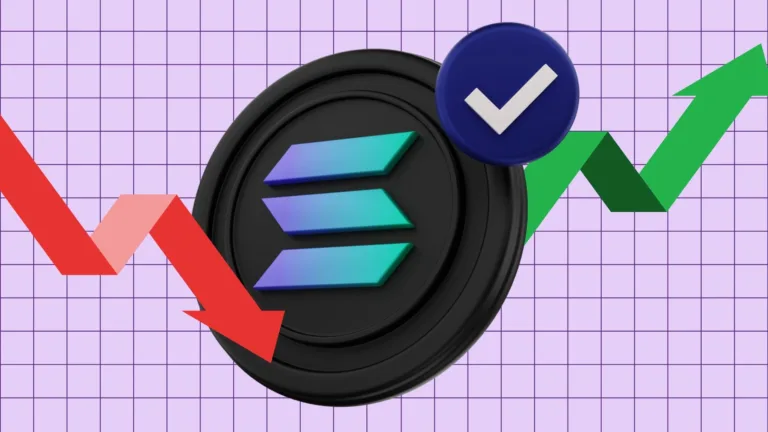Will ETH Reach $25,000?
Ethereum’s potential to reach $25,000 is supported by its innovative technology, and a growing institutional interest.
However, market volatility poses risks and opportunities, while regulatory challenges remain a concern for developers and investors.
Further insights into these dynamics shed light on Ethereum’s path to $25,000 and the key factors driving its growth. In this article, we break down the essential points to watch.
Key Takeaways:
Hide- Smart Contracts and Scalability Enhancements: Ethereum’s robust foundation in smart contracts and decentralized applications is set to receive a significant boost with the upcoming Pectra upgrade, scheduled for early 2025.
- This upgrade is expected to enable externally owned accounts (EOAs) to run like smart contracts, thereby improving wallet scalability, user experience, and security. (Source: panewslab.com)
- Decentralized Finance and NFT Momentum: The continuous development and adoption of DeFi platforms, coupled with strong growth in the NFT sector, are pivotal in enhancing Ethereum’s utility.
- This dual momentum not only drives demand for ETH but also contributes to a broader bullish sentiment that could propel its price upward.
- Institutional Adoption and Regulatory Clarity: Growing institutional interest bolsters Ethereum’s credibility and long-term investment appeal.
- For Ethereum to hit new highs, major economies, particularly the U.S. must adopt favorable regulatory policies, replacing current headwinds with clarity and acceptance.
- Market Volatility and Bullish Price Surge Opportunities: While inherent market volatility poses risks, it also creates windows for dramatic price surges.
- Optimistic projections suggest that if the stars align, with technological upgrades, AI integration, and regulatory tailwinds, Ethereum could experience a meteoric rise to levels like $25,000. (Source: panewslab.com)
- Integration of AI and Ecosystem Innovation: A key emerging factor is the anticipated integration of AI agents into the Ethereum ecosystem.
- This technological infusion is expected to spawn innovative decentralized applications and services, further expanding Ethereum’s functionality and driving institutional and user interest.
Ethereum’s Technology and Use Cases

Although Ethereum is often recognized primarily as a cryptocurrency, its underlying technology and diverse use cases extend far beyond mere financial transactions.
At its core, Ethereum operates on a decentralized platform powered by blockchain technology, enabling the creation of smart contracts.
These self-executing contracts facilitate trustless agreements across various sectors, ranging from supply chain management to digital identity verification.
Additionally, Ethereum supports decentralized applications (dApps), allowing developers to build innovative solutions that disrupt traditional business models.
The platform’s adaptability to integrate with emerging technologies, such as the Internet of Things and artificial intelligence, enhances its potential.
Consequently, Ethereum not only serves as a financial instrument but also as a foundational technology driving digital transformation across multiple industries.
The Growth of Decentralized Finance (DeFi)

The growth of decentralized finance (DeFi) has notably influenced the Ethereum ecosystem, driving both innovation and adoption.
As more users engage with DeFi platforms, Ethereum’s utility and demand increase, which may contribute to its potential price trajectory.
This expanding ecosystem raises critical questions about the sustainability and scalability of DeFi applications within the broader financial landscape.
DeFi Ecosystem Expansion
As the DeFi ecosystem continues to expand, it is reshaping traditional financial paradigms by providing users with unprecedented access to financial services without the need for intermediaries.
This growth is characterized by the emergence of decentralized applications (dApps) that facilitate lending, borrowing, and trading directly on blockchain networks.
The increasing integration of automated smart contracts enhances efficiency and transparency, attracting both retail and institutional investors.
In addition, innovative liquidity protocols and yield farming strategies are driving capital into DeFi projects, fostering a competitive landscape.
However, the rapid development also brings regulatory scrutiny and security challenges, which may impact investor confidence.
Increased Ethereum Adoption
How has the surge in decentralized finance (DeFi) contributed to the increased adoption of Ethereum?
The rapid expansion of DeFi platforms has greatly heightened Ethereum’s utility and relevance within the blockchain ecosystem.
By enabling innovative financial services such as lending, borrowing, and yield farming without traditional intermediaries, DeFi has attracted a diverse user base seeking alternatives to conventional finance.
As more projects launch on Ethereum, the network’s demand escalates, fostering a robust community of developers and investors.
In addition, the ability to create smart contracts enhances the transparency and security of financial transactions, appealing to those prioritizing trust.
This convergence of technological advancement and practical application positions Ethereum as a pivotal player in reshaping the future of finance, driving its adoption forward.
Institutional Interest and Adoption of Ethereum

The increasing institutional interest in Ethereum reflects a significant shift in the perception of digital assets as viable investment opportunities.
Major partnerships and collaborations between Ethereum projects and established financial entities further underscore this trend, enhancing the network’s credibility and utility.
Additionally, evolving regulatory frameworks are likely to play a vital role in shaping the landscape for Ethereum adoption among institutional investors.
Growing Institutional Investments
Despite the inherent volatility of cryptocurrency markets, growing institutional investments in Ethereum indicate a significant shift in the financial landscape.
Major financial institutions are increasingly allocating resources to Ethereum, recognizing its potential as a robust platform for decentralized applications and smart contracts.
This influx of capital not only enhances liquidity but also legitimizes Ethereum as a viable asset class.
Moreover, institutional investors are motivated by Ethereum’s change to a proof-of-stake model, which promises increased energy efficiency and scalability.
As these entities engage with Ethereum, they contribute to a broader acceptance of blockchain technology, fostering innovation and potentially driving demand.
This evolving interest could be pivotal in shaping Ethereum’s future value and stability in an evolving digital economy.
Major Partnerships and Collaborations
Growing institutional investments in Ethereum have laid the groundwork for significant partnerships and collaborations that further enhance its adoption.
Major players across various sectors are recognizing Ethereum’s potential, leading to strategic alliances that bolster its ecosystem.
These partnerships often focus on innovation, scalability, and the integration of decentralized applications.
| Partner | Industry | Purpose |
|---|---|---|
| Microsoft | Technology | Azure Blockchain Service |
| JPMorgan | Finance | Quorum, a private blockchain |
| Deloitte | Consulting | Blockchain solutions |
| ChainSafe | Development | Ethereum integration tools |
| ConsenSys | Software | Enterprise Ethereum solutions |
Regulatory Developments Impacting Adoption
As regulatory clarity surrounding cryptocurrencies improves, institutional interest in Ethereum is expected to rise considerably.
Recent developments, including clearer guidelines from regulatory bodies, have created a more conducive environment for institutional investors.
With the potential for Ethereum to support a wide array of decentralized applications and financial services, institutions are increasingly recognizing its value.
Furthermore, compliance measures and regulatory frameworks are being established to mitigate risks, thereby enhancing trust among institutional players.
This shift towards regulatory acceptance could facilitate larger investments in Ethereum and promote broader adoption.
Market Volatility and Its Impact on ETH

How does market volatility influence the trajectory of Ethereum (ETH) in the ever-changing landscape of cryptocurrencies?
Market volatility serves as a double-edged sword for ETH, presenting both risks and opportunities.
Price fluctuations often lead to heightened speculation, attracting short-term traders who seek to capitalize on rapid changes.
This behavior can create significant price swings, making ETH susceptible to abrupt declines or surges.
Market volatility creates both risks and opportunities for ETH, drawing in speculators and leading to significant price fluctuations.
Additionally, volatility can deter institutional investment, as large entities typically prefer stable assets.
Conversely, periods of volatility can also trigger increased interest and innovation in DeFi applications built on Ethereum, as developers explore new solutions to mitigate risks.
All in all, sustained volatility challenges ETH’s potential for mainstream adoption while also fostering a dynamic environment for technological advancement.
Regulatory Challenges Facing Ethereum
Although regulatory frameworks surrounding cryptocurrencies are still evolving, Ethereum faces significant challenges that could impact its future growth and adoption.
One major concern is the classification of Ether as a security or a commodity, which could subject it to stringent regulatory oversight.
In addition, international regulatory variances create uncertainty for developers and investors alike, as compliance with diverse jurisdictions can be burdensome.
Moreover, the push for decentralized finance (DeFi) has raised alarms among regulators regarding consumer protection and anti-money laundering measures.
These concerns may lead to restrictive policies that stifle innovation within the Ethereum ecosystem.
Expert Predictions for Ethereum’s Price
What factors will shape the future price of Ethereum? Expert predictions highlight several key elements influencing ETH’s trajectory.
Market sentiment, driven by technological advancements and increased adoption of decentralized applications, plays a vital role.
Analysts point to Ethereum’s shift to a proof-of-stake model, which could enhance scalability and energy efficiency, potentially attracting institutional investors.
In addition, macroeconomic indicators, such as inflation rates and global economic stability, will also impact investor confidence.
Regulatory developments are essential, as clearer frameworks could either bolster or hinder growth.
Finally, the rise of competing platforms may influence Ethereum’s market share, prompting stakeholders to reassess its valuation.
Collectively, these factors provide a complex landscape for forecasting Ethereum’s price potential.
Historical Price Trends of Ethereum

As Ethereum has evolved since its inception in 2015, its price trends have exhibited notable volatility, reflecting a complex interplay of market dynamics and investor sentiment.
Initially priced below $1, Ethereum experienced a meteoric rise in 2017, peaking at over $1,400, driven by the ICO boom and growing interest in decentralized applications.
Subsequent corrections revealed the market’s sensitivity to regulatory developments and technological challenges.
The introduction of Ethereum 2.0 in 2020 sparked renewed interest, leading to a resurgence in price, culminating in highs above $4,800 in late 2021.
Fluctuations continued into 2023, with macroeconomic factors and competition influencing investor confidence.
From January 2024 to early 2025, Ethereum experienced a roller-coaster ride: a strong early-year rally, a harsh summer downturn, a euphoric year-end surge, and a dramatic crash back to square one.
The price fluctuated between highs near $4,000 and lows around $2,200, with multiple swings exceeding 30% in between. However, some experts suggest that 1 Ethereum value could reach $15,000 in 2025.
Comparing Ethereum With Other Cryptocurrencies
How does Ethereum stack up against other leading cryptocurrencies with respect to technology, use cases, and market performance?
Ethereum, as a pioneer in smart contract functionality, offers a robust platform for decentralized applications (dApps), attracting developers across various sectors.
Its adaptability with Ethereum 2.0 enhances scalability and energy efficiency, positioning it favorably against competitors like Cardano and Solana, which also emphasize innovation in transaction speed and lower fees.
Market performance reveals Ethereum’s strong second position following Bitcoin, frequently exhibiting resilience during market fluctuations.
Ethereum maintains a solid second position behind Bitcoin, demonstrating remarkable resilience amid market volatility.
In evaluating use cases, Ethereum’s versatility in finance, gaming, and NFTs underscores its dominant role.
Ultimately, while other cryptocurrencies aim for technological advancements, Ethereum’s established ecosystem and ongoing innovations solidify its competitive edge.
Long-Term Outlook for Ethereum and the $25,000 Target
Could Ethereum realistically achieve a price target of $25,000 in the long term? Analysts believe that several factors could support such a valuation.
As Ethereum evolves, its changeover to a proof-of-stake model enhances scalability and energy efficiency, attracting more developers and investors.
The growth of decentralized finance (DeFi) and non-fungible tokens (NFTs) continues to increase Ethereum’s utility, fostering demand for the cryptocurrency.
Additionally, institutional interest and regulatory clarity may further legitimize Ethereum as a long-term investment.
However, risks such as market volatility, competition from other blockchains, and potential regulatory challenges must be considered.
Ultimately, while a $25,000 target is ambitious, it is not outside the scope of possibility given Ethereum’s foundational strengths and ongoing innovations.
Wrapping Up
In the quest to determine whether Ethereum will reach $25,000, one might find it amusing that the very technology designed to decentralize finance is often at the mercy of centralized market whims.
As institutional interest surges, regulatory challenges loom, and volatility reigns, the irony lies in the unpredictability of a cryptocurrency that aims to revolutionize the financial landscape.
Finally, while predictions abound, the journey of Ethereum’s price to $25,000 remains as uncertain as the future of digital assets themselves.







